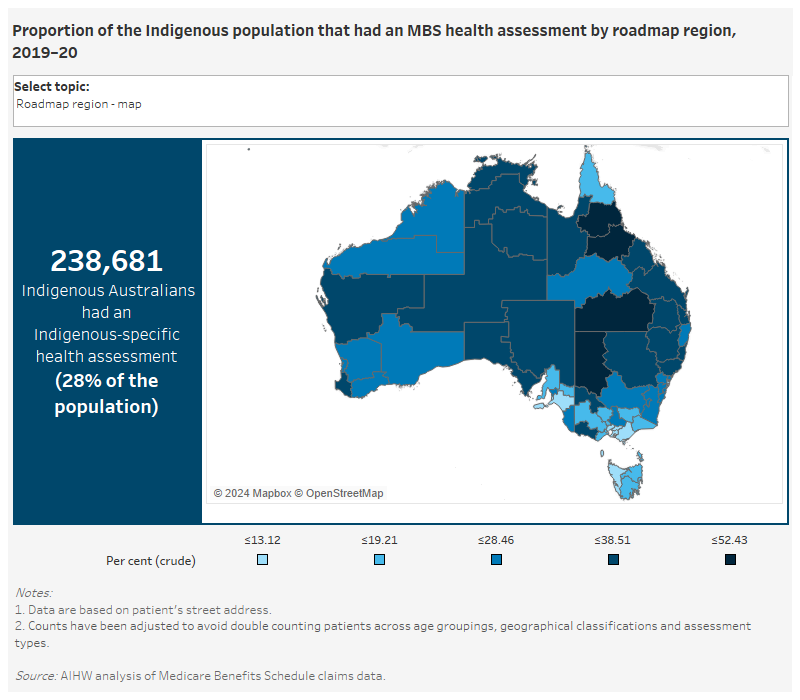Annual health assessments
Measure 2.1: The number of people who had an Indigenous health assessment (MBS item 715 or 228) including a health assessment provided via videoconference or teleconference (MBS item 92004, 92011, 92016, 92023), proportion of the population and age-standardised rates
Where a person had both an in-person health check and a telehealth check in a year, one health check was selected at random for inclusion in the analysis.
All Aboriginal and Torres Strait Islander Australians, regardless of age, are eligible for an Indigenous-specific health assessment which includes an eye health check.
There are 8 separate charts for this measure, including 3 maps, showing MBS health assessments, for Indigenous Australians by various characteristics.
Proportion of the Indigenous population that had an MBS health assessment by PHN, 2019–20 (map)
This map of Australia compares the proportion of MBS Indigenous health assessments in 2019–20, by PHN. The proportions for each PHN are grouped into 5 categories, ranging from proportions of less than or equal to 13.53% in the lowest category to proportions more than 31.12% but less than or equal to 38.97% in the highest category.
Proportion of the Indigenous population that had an MBS health assessment by PHN, 2019–20 (bar chart)
This horizontal bar chart shows the proportion of MBS health assessments in 2019–20, by PHN. The chart shows that the PHNs with the lowest proportion of health assessments were Northern Sydney (5.2%) and South Eastern Melbourne (8.4%), while those with the highest rates were Western Queensland (39%) and Western NSW (37%).
Proportion of the Indigenous population that had an MBS health assessment by roadmap region, 2019–20 (map)
This map of Australia compares the proportion of MBS health assessments in 2019–20, by roadmap regions. The proportions for each roadmap region are grouped into 5 categories, ranging from proportions of less than or equal to 13.12% in the lowest category to proportions from 38.52% to 52.43% in the highest category. The roadmap regions with the highest proportion of MBS health assessments were South West Queensland (52.4%), and Townsville/Palm Island (48.1%), while those with the lowest rates were Eastern Metropolitan Melbourne (5.3%) and Northern Metropolitan Sydney (5.4%).
Number and proportion of Indigenous Australians that had an MBS health assessment, 2018–19 and 2019–20
This dual axis combined vertical bar chart and scatter plot displays the number and proportion of MBS health assessments in 2018–19 and 2019–20. The chart shows that 28% of Indigenous Australians (or 238,681 people) had Indigenous-specific MBS health assessments in 2019–20. This is a decline of 2,343 assessments from 2018–19.
Proportion of the Indigenous population that had an MBS health assessment by age, 2010–11 to 2019–20
This line graph shows changes in the proportion of MBS health assessments, from 2010–11 to 2019–20, by age group. The chart shows that, between 2010–11 and 2019–20, the age-standardised proportion of MBS health assessments increased over time. This increase occurred across all age groups, but was highest for those aged 65–74 and 75 and over (from around 18% to around 39% for both groups).
Proportion of the Indigenous population that had an MBS health assessment by age and sex, 2019–20
This grouped vertical bar chart compares the proportion of MBS item 715 health assessments in 2019–20, by age and by sex. The chart shows that the number and proportion of MBS health assessments were very similar for Indigenous males and females aged 0–14— 27% and 26%, respectively. For all other age groups, health assessments for Indigenous females outnumbered those for Indigenous males.
Proportion of the Indigenous population that had an MBS health assessment by region, 2019–20
This vertical bar chart compares the proportion of MBS health assessments in 2019–20, by remoteness category of geographic location. The chart shows that the proportion of MBS 715 health assessments was the same in Outer regional and Remote areas (34.3%). The proportion was lowest in Major cities (24%).
Proportion of the Indigenous population that had an MBS health assessment by jurisdiction, 2019–20
This vertical bar chart compares the proportion of MBS health assessments in 2019–20, by state and territory. The chart shows that the proportion of MBS health assessments was highest in Queensland (35%) and the Northern Territory (34%), and was lowest in Victoria and Tasmania (both around 15%).

- In 2019–20, just under one-third (238,700 or 28%) of Indigenous Australians had an Indigenous-specific health assessment. This included over 9,300 health assessments provided via videoconference or teleconference (see Tracking progress against the Implementation Plan goals for the Aboriginal and Torres Strait Islander Health Plan 2013–2023, supplementary tables).
- The age-standardised proportion of Indigenous Australians who had a health assessment increased from around 9% in 2010–11 to 28% for the under 15 age group and 27% for the 15–54 age group in 2018–19, before declining to just under 27% for both age groups in 2019–20. For those aged 55 and over the proportion rose from 17% in 2010–11 to 37% in 2017–18, before plateauing at 38% in 2018–19 and 2019–20.
- In 2019–20, the number and proportion of Indigenous males aged 0–14 who had a health assessment was slightly higher than the number and proportion of females—39,082 (27%) and 35,641 (26%), respectively. For all other age groups, health assessments for Indigenous females outnumbered those for Indigenous males.


